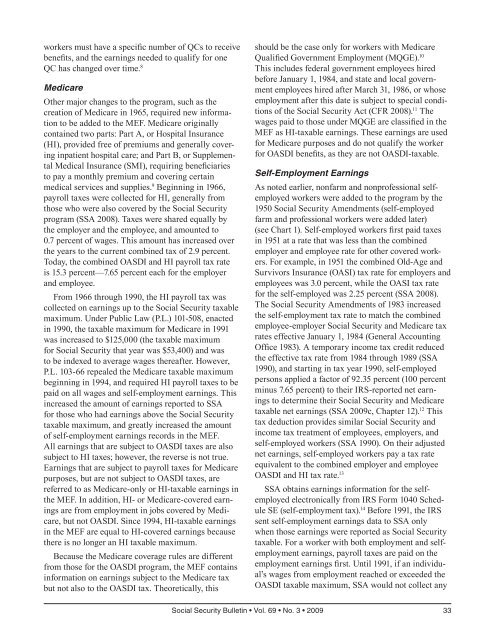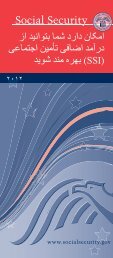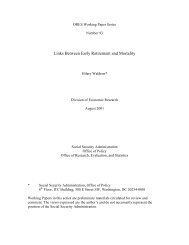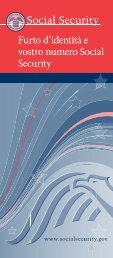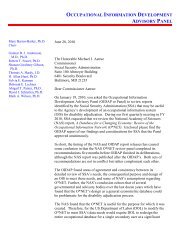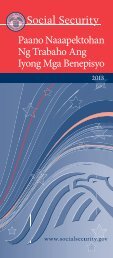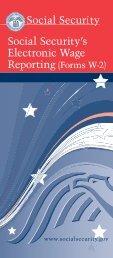Download entire publication - Social Security
Download entire publication - Social Security
Download entire publication - Social Security
You also want an ePaper? Increase the reach of your titles
YUMPU automatically turns print PDFs into web optimized ePapers that Google loves.
workers must have a specific number of QCs to receivebenefits, and the earnings needed to qualify for oneQC has changed over time. 8MedicareOther major changes to the program, such as thecreation of Medicare in 1965, required new informationto be added to the MEF. Medicare originallycontained two parts: Part A, or Hospital Insurance(HI), provided free of premiums and generally coveringinpatient hospital care; and Part B, or SupplementalMedical Insurance (SMI), requiring beneficiariesto pay a monthly premium and covering certainmedical services and supplies. 9 Beginning in 1966,payroll taxes were collected for HI, generally fromthose who were also covered by the <strong>Social</strong> <strong>Security</strong>program (SSA 2008). Taxes were shared equally bythe employer and the employee, and amounted to0.7 percent of wages. This amount has increased overthe years to the current combined tax of 2.9 percent.Today, the combined OASDI and HI payroll tax rateis 15.3 percent—7.65 percent each for the employerand employee.From 1966 through 1990, the HI payroll tax wascollected on earnings up to the <strong>Social</strong> <strong>Security</strong> taxablemaximum. Under Public Law (P.L.) 101-508, enactedin 1990, the taxable maximum for Medicare in 1991was increased to $125,000 (the taxable maximumfor <strong>Social</strong> <strong>Security</strong> that year was $53,400) and wasto be indexed to average wages thereafter. However,P.L. 103-66 repealed the Medicare taxable maximumbeginning in 1994, and required HI payroll taxes to bepaid on all wages and self-employment earnings. Thisincreased the amount of earnings reported to SSAfor those who had earnings above the <strong>Social</strong> <strong>Security</strong>taxable maximum, and greatly increased the amountof self-employment earnings records in the MEF.All earnings that are subject to OASDI taxes are alsosubject to HI taxes; however, the reverse is not true.Earnings that are subject to payroll taxes for Medicarepurposes, but are not subject to OASDI taxes, arereferred to as Medicare-only or HI-taxable earnings inthe MEF. In addition, HI- or Medicare-covered earningsare from employment in jobs covered by Medicare,but not OASDI. Since 1994, HI-taxable earningsin the MEF are equal to HI-covered earnings becausethere is no longer an HI taxable maximum.Because the Medicare coverage rules are differentfrom those for the OASDI program, the MEF containsinformation on earnings subject to the Medicare taxbut not also to the OASDI tax. Theoretically, thisshould be the case only for workers with MedicareQualified Government Employment (MQGE). 10This includes federal government employees hiredbefore January 1, 1984, and state and local governmentemployees hired after March 31, 1986, or whoseemployment after this date is subject to special conditionsof the <strong>Social</strong> <strong>Security</strong> Act (CFR 2008). 11 Thewages paid to those under MQGE are classified in theMEF as HI-taxable earnings. These earnings are usedfor Medicare purposes and do not qualify the workerfor OASDI benefits, as they are not OASDI-taxable.Self-Employment EarningsAs noted earlier, nonfarm and nonprofessional selfemployedworkers were added to the program by the1950 <strong>Social</strong> <strong>Security</strong> Amendments (self-employedfarm and professional workers were added later)(see Chart 1). Self-employed workers first paid taxesin 1951 at a rate that was less than the combinedemployer and employee rate for other covered workers.For example, in 1951 the combined Old-Age andSurvivors Insurance (OASI) tax rate for employers andemployees was 3.0 percent, while the OASI tax ratefor the self-employed was 2.25 percent (SSA 2008).The <strong>Social</strong> <strong>Security</strong> Amendments of 1983 increasedthe self-employment tax rate to match the combinedemployee-employer <strong>Social</strong> <strong>Security</strong> and Medicare taxrates effective January 1, 1984 (General AccountingOffice 1983). A temporary income tax credit reducedthe effective tax rate from 1984 through 1989 (SSA1990), and starting in tax year 1990, self-employedpersons applied a factor of 92.35 percent (100 percentminus 7.65 percent) to their IRS-reported net earningsto determine their <strong>Social</strong> <strong>Security</strong> and Medicaretaxable net earnings (SSA 2009c, Chapter 12). 12 Thistax deduction provides similar <strong>Social</strong> <strong>Security</strong> andincome tax treatment of employees, employers, andself-employed workers (SSA 1990). On their adjustednet earnings, self-employed workers pay a tax rateequivalent to the combined employer and employeeOASDI and HI tax rate. 13SSA obtains earnings information for the selfemployedelectronically from IRS Form 1040 ScheduleSE (self-employment tax). 14 Before 1991, the IRSsent self-employment earnings data to SSA onlywhen those earnings were reported as <strong>Social</strong> <strong>Security</strong>taxable. For a worker with both employment and selfemploymentearnings, payroll taxes are paid on theemployment earnings first. Until 1991, if an individual’swages from employment reached or exceeded theOASDI taxable maximum, SSA would not collect any<strong>Social</strong> <strong>Security</strong> Bulletin • Vol. 69 • No. 3 • 2009 33


